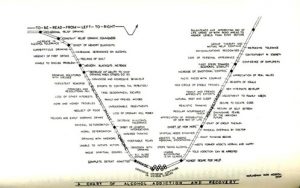E. M. “Bunky” Jellinek’s fascination with the progression of alcoholism began after the publication in 1946 of his “Phases in the drinking history of alcoholics.” The study was controversial: it relied on a questionnaire designed by and given to members of Alcoholics Anonymous, and only a small sample of the responses – 98 hand chosen by Jellinek from 158 received out of 1600 – figured into the analysis. Still, it was enough to convince him that the progression of alcoholism followed a discernible pattern.

The Bunky Doodle
By 1950, an initial sketch (literally!) of what the progression looked like was presented to an audience at the eighth annual Summer School of Alcohol Studies at Yale University.
A more detailed questionnaire was then developed and administered to over 2000 male alcoholics. Originally published as an annex to a 1952 World Health Organization report, his “Phases of alcohol addiction” elaborated on what he took to be the four phases every alcoholic experienced with corresponding physical and mental characteristics.

“Phases of “Phases of Alcoholism” in George Strachan, Alcoholism: Treatable Illness (Victoria, BC: Orca Book Publishers, 1990), p. 108.
Within a few years, Max M. Glatt, a doctor and founder of the Alcoholism Treatment Unit at Warlingham Park Hospital in England, noticed that former patients recounted similar recovery experiences after leaving the hospital. Glatt revised Jellinek’s chart to include this upswing of recovery. Although Jellinek himself was not responsible for this addition, the “Jellinek curve” still bears his name.

From M. M. Glatt (1958). Group therapy in alcoholism. British Journal of Addiction, 54 (2): 140.
The Jellinek curve has since been widely popularized and is a sine qua non of substance abuse treatment centers.
Varieties of the Jellinek curve include, for example:

This copy was distributed by the Alcoholism Council of Greater Los Angeles. 1957 ©Doyle F. Landley
It is sometimes stated that Jellinek later disassociated himself from his “Phases of alcohol addiction” chart. However, this does not appear to be the case. For one thing, the paper was republished with only slight modifications in Society, Culture, and Drinking Patterns, the central compilation of alcohol sociology for the time. The book was published in 1962, a year before Jellinek’s death. More importantly, the accusation ignores a close reading of the original text and its consistency with Jellinek’s most famous work, The Disease Concept of Alcoholism. The 1952 progression, which is described as “characteristic” and representing an “average trend,” only applies to the class of alcoholics called “alcohol addicts.” By 1960, when The Disease Concept of Alcoholism was published, Jellinek would call them gamma alcoholics, noting that “[i]n gamma alcoholism there is a definite progression from psychological to physical dependence and marked behavior changes such as have been described previously” (p. 37).
The Jellinek curve inspired addiction scientists and practitioners. Adaptations in other fields include the Chart of compulsive gambling & recovery developed by Custer and Rosenthal. It defines and identifies the stages of a compulsive gambling similarly to the stages of alcoholism and is widely used in gambling addiction treatment.

–Originally published in the December 2012 issue of the CAS Information Services Newsletter. Written by Scott Goldstein.
